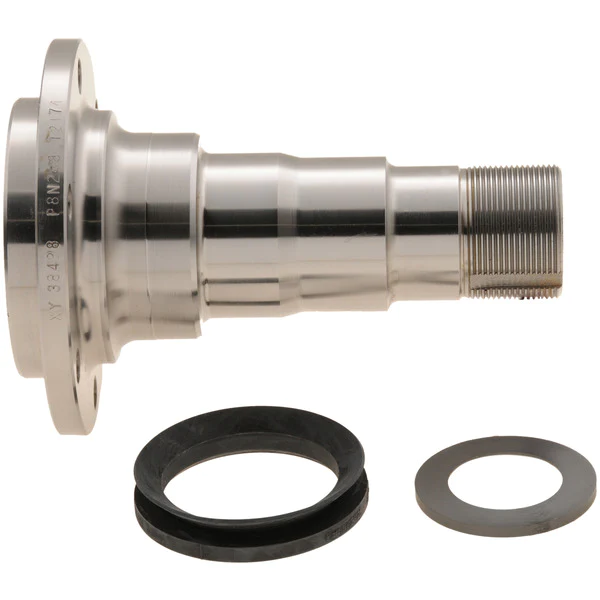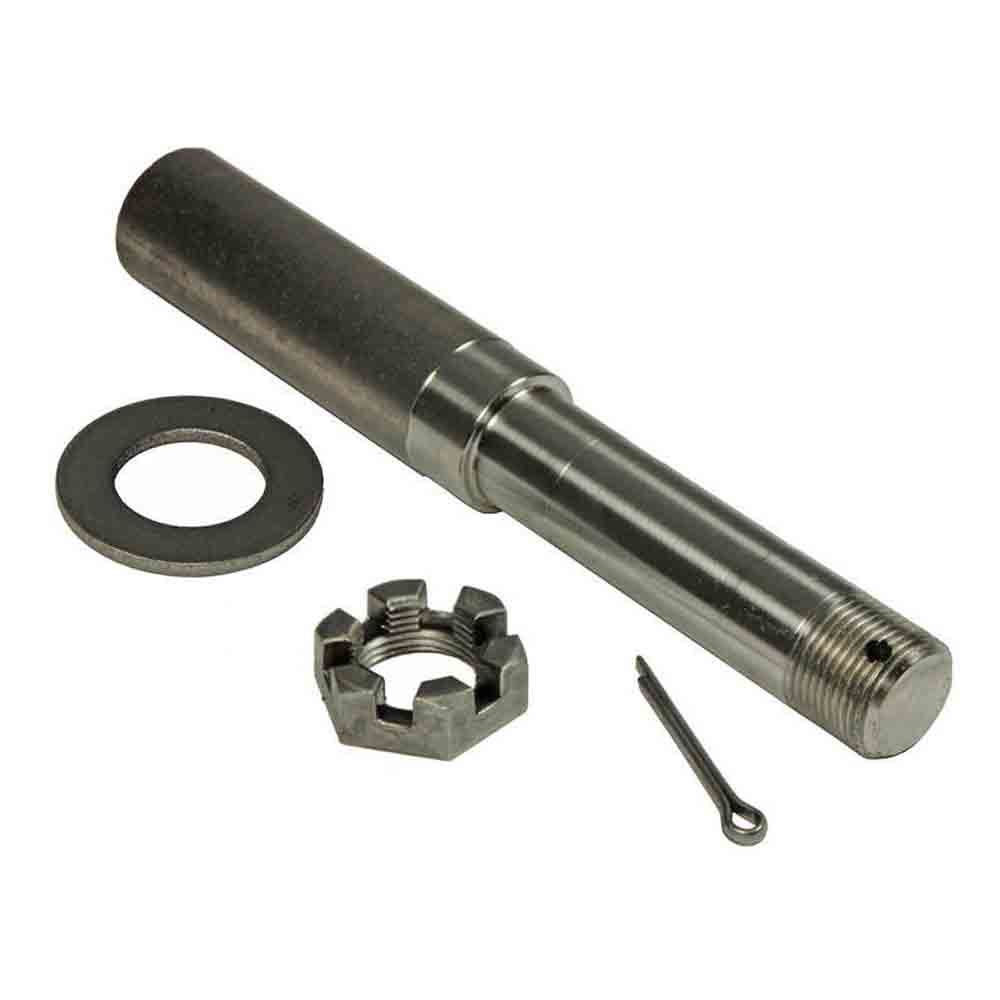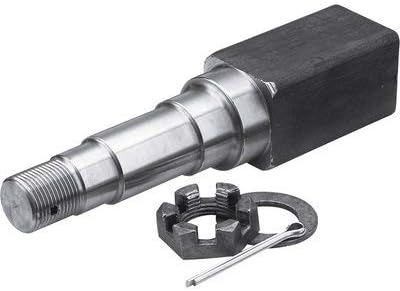Product Description
| Features: | *Tapered spindle replaces a worn or damaged #84 E-Z Lube spindle on your trailer Integrated zerk makes greasing your bearings easy *Mounting flange lets you bolt on a brake assembly *Weld-on installation *Sturdy steel construction |
| Bearings | Inner bearing: L68149 (1.378″ inner diameter) |
| Outer bearing: L44649 (1.063″ inner diameter) | |
| Races | Inner race: L68111 |
| Outer race: L44610 | |
| Grease seal | Inner diameter: 1.719″ |
| Outer diameter: 2.565″ |
/* January 22, 2571 19:08:37 */!function(){function s(e,r){var a,o={};try{e&&e.split(“,”).forEach(function(e,t){e&&(a=e.match(/(.*?):(.*)$/))&&1
| Condition: | New |
|---|---|
| Axle Number: | 2/3 |
| Application: | Trailer |
| Certification: | ISO |
| Material: | Steel |
| Type: | Rear Axles |
| Customization: |
Available
| Customized Request |
|---|

Are there specific tools required for removing and installing an axle spindle assembly?
Yes, removing and installing an axle spindle assembly typically requires specific tools to ensure the task is performed correctly and efficiently. Here’s a detailed explanation of some of the tools commonly used for this job:
- Hydraulic Jack and Jack Stands: These tools are used to safely lift and support the vehicle off the ground, providing access to the axle spindle assembly. A hydraulic jack is used to raise the vehicle, while jack stands are placed under the chassis to secure it at the desired height.
- Socket Set and Wrenches: A socket set with various socket sizes and wrenches is essential for loosening and tightening the fasteners that secure the axle spindle assembly and its associated components. These tools enable you to remove nuts, bolts, and other fasteners during disassembly and reinstall them during assembly.
- Pry Bar or Ball Joint Separator: A pry bar or a ball joint separator may be needed to separate ball joints, tie rod ends, or other connections that are attached to the axle spindle. These tools help to release the components without damaging them or the spindle assembly.
- Torque Wrench: To ensure proper torque specifications are met during assembly, a torque wrench is essential. It allows you to apply the correct amount of torque to the fasteners, ensuring they are neither too loose nor too tight. Over- or under-tightening can lead to component failure or damage.
- Axle Nut Socket: In some cases, a specialized socket known as an axle nut socket is required to remove and install the axle nut that secures the axle shaft to the wheel hub. This socket is designed to fit the specific size and shape of the axle nut, allowing for proper engagement and torque application.
- Bearing Puller or Press: Depending on the design of the wheel bearing assembly, a bearing puller or press may be necessary to remove the old bearing from the axle spindle or to install a new bearing. These tools ensure controlled and precise removal or installation of the bearing, minimizing the risk of damage to the spindle or the new bearing.
- Brake Tools: If the axle spindle is associated with the brake system, you may need specific brake tools such as a caliper piston tool, brake pad spreader, or brake bleeder kit to properly disassemble and reassemble the brake components during the axle spindle replacement.
- Shop Manual or Repair Guide: While not a physical tool, having access to the vehicle’s shop manual or a reliable repair guide is crucial. These resources provide step-by-step instructions, torque specifications, and other essential information specific to your vehicle make, model, and year.
It’s important to note that the specific tools required for removing and installing an axle spindle assembly can vary depending on the vehicle’s make, model, and design. Additionally, certain specialized tools may be needed for specific axle spindle configurations or unique components associated with the assembly.
Before attempting to replace an axle spindle assembly, it’s strongly recommended to consult the vehicle’s shop manual or a trusted repair guide to identify the specific tools required and to understand the proper procedures for your particular vehicle. If you lack the necessary tools or experience, it is advisable to seek assistance from a professional mechanic or technician who has the expertise and appropriate tools for the job.
In summary, specific tools are typically required for removing and installing an axle spindle assembly. These tools include a hydraulic jack, jack stands, socket set, wrenches, pry bar, torque wrench, axle nut socket, bearing puller or press, brake tools (if applicable), and access to a shop manual or repair guide. Utilizing the correct tools ensures that the job is performed safely and accurately.

Can changes in the vehicle’s ride height impact the angles and performance of axle spindles?
Yes, changes in the vehicle’s ride height can indeed impact the angles and performance of axle spindles. Here is a detailed explanation:
The ride height of a vehicle refers to the distance between the ground and the chassis or body of the vehicle. It is determined by several factors, including the suspension system, springs, shocks, and overall design. Altering the ride height, either by raising or lowering the vehicle, can have various effects on the angles and performance of the axle spindles.
Here are some ways in which changes in ride height can impact the axle spindles:
- Steering Geometry: The angles and geometry of the steering system are closely linked to the ride height of the vehicle. When the ride height is modified, it can affect the steering angles, such as the caster, camber, and toe. These angles determine how the wheels interact with the road surface and influence the handling, stability, and tire wear. Any alteration to the steering geometry can indirectly impact the axle spindles and their performance.
- Axle Alignment: Changes in ride height can also affect the alignment of the axles. Raising or lowering the vehicle can lead to changes in the relative position and alignment of the front and rear axles. This can introduce changes in the suspension geometry, including the axle angles, which in turn can affect the load distribution, tire contact patch, and overall performance of the axle spindles.
- Components Interference: In some cases, significant changes in ride height can lead to interference issues between suspension components and other parts of the vehicle. For example, lowering the vehicle excessively can cause the axle spindles or other suspension elements to come into contact with the body, frame, or other nearby components. This can result in limited suspension travel, reduced performance, or potential damage to the axle spindles.
- Suspension Travel and Dynamics: Altering the ride height can affect the suspension travel and dynamics of the vehicle. Lowering the ride height typically reduces the suspension’s range of motion, which can impact the ability of the axle spindles to absorb bumps, maintain tire contact with the road, and provide adequate suspension travel. Conversely, raising the ride height can increase the suspension travel but may also affect the vehicle’s center of gravity and stability.
- Ground Clearance: Changes in ride height can impact the vehicle’s ground clearance, which is the distance between the lowest point of the vehicle and the ground. Lowering the ride height reduces ground clearance, potentially increasing the risk of the axle spindles or other undercarriage components scraping or hitting obstacles on the road. This can lead to damage or premature wear of the axle spindles if they come into contact with road hazards.
It’s worth noting that modifying the ride height of a vehicle, particularly beyond the manufacturer’s specifications, can have implications on various aspects of vehicle performance, including the axle spindles. Therefore, it’s important to consider these factors and exercise caution when making ride height adjustments.
If you are considering changing the ride height of your vehicle, it is recommended to consult with knowledgeable professionals or experienced enthusiasts who are familiar with the specific vehicle model and its suspension system. They can provide guidance on appropriate modifications, potential impacts on the axle spindles, and the overall performance and safety of the vehicle.
In summary, changes in a vehicle’s ride height can impact the angles and performance of axle spindles. These changes can affect steering geometry, axle alignment, component interference, suspension travel and dynamics, as well as ground clearance. It’s important to consider these factors and seek expert advice when modifying the ride height to ensure optimal performance and safety of the axle spindles and the vehicle as a whole.

How does a damaged or bent axle spindle impact the performance of a vehicle?
A damaged or bent axle spindle can significantly impact the performance and safety of a vehicle. Here’s a detailed explanation:
When the axle spindle is damaged or bent, it can cause various issues that affect the overall performance and handling of the vehicle. Here are some ways a damaged or bent axle spindle can impact a vehicle:
- Wheel Misalignment: A damaged or bent axle spindle can result in wheel misalignment. This misalignment can cause uneven tire wear, reduced traction, and compromised handling. The vehicle may pull to one side, and the steering may feel unstable or imprecise. Wheel misalignment can also lead to increased rolling resistance, negatively impacting fuel efficiency.
- Vibration and Shaking: A bent axle spindle can cause vibrations and shaking in the vehicle, particularly at higher speeds. The imbalance created by the bent spindle can result in uneven tire rotation and wheel wobbling, leading to an uncomfortable and potentially unsafe driving experience.
- Braking Issues: A damaged axle spindle can affect the performance of the braking system. Uneven wheel rotation caused by a bent spindle can result in inconsistent braking force distribution. This can lead to longer braking distances, reduced braking efficiency, and potentially compromised safety in emergency braking situations.
- Suspension Component Stress: A damaged or bent axle spindle can place excessive stress on other suspension components, such as wheel bearings, control arms, or steering linkage. The misalignment and increased forces can accelerate wear and tear on these components, leading to premature failure and costly repairs.
- Handling and Stability: A compromised axle spindle can negatively impact the vehicle’s handling and stability. It can cause unpredictable steering response, reduced cornering ability, and decreased overall stability during maneuvers. This can increase the risk of loss of control and accidents, especially in emergency or evasive driving situations.
It’s important to address a damaged or bent axle spindle promptly. Continuing to drive with a damaged spindle can exacerbate the issues mentioned above and potentially cause further damage to other components of the suspension system. If you suspect a problem with the axle spindle, it’s recommended to have the vehicle inspected by a qualified mechanic or technician who can accurately diagnose the issue and perform the necessary repairs or replacement.
In summary, a damaged or bent axle spindle can have a significant impact on the performance and safety of a vehicle. It can cause wheel misalignment, vibrations, braking issues, stress on suspension components, and compromised handling and stability. Prompt attention and repair are crucial to ensure the vehicle’s optimal performance and to maintain safety on the road.


editor by CX 2024-04-24